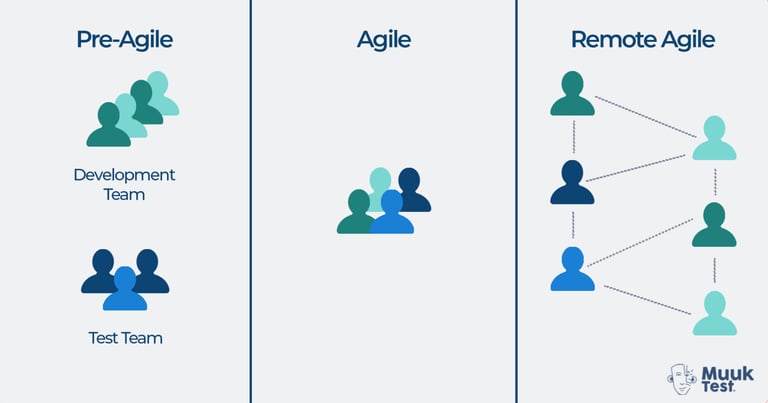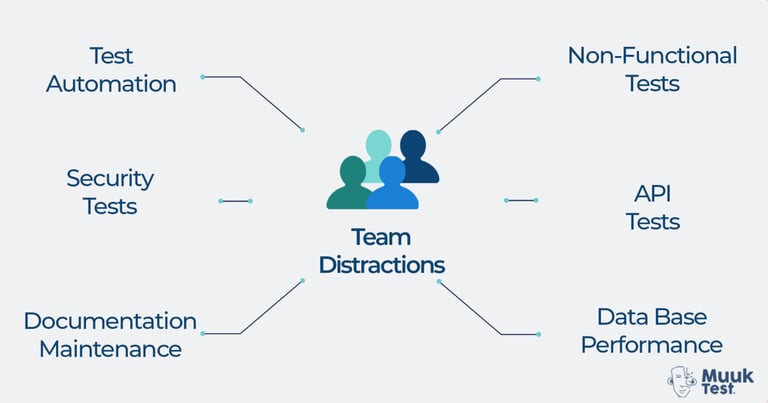One thing that COVID evidently changed forever is the way we work; remote and virtual teams are the new normal. COVID certainly pushed the Medicine practitioners to an edge, but also HR teams and Managers. From onboarding to exit processes, everything went virtual. As the famous saying goes, “every risk comes with an opportunity.” COVID allowed us to realize it is possible to run the show virtually.
Remote teams offer great benefits to hiring managers. Sourcing has never been this easy. Remote working has opened a magical door giving access to the wider world. Let’s examine a quality engineering team in deep case analysis and check out how to build an effective QA team.
QE’s/testers have been co-located with the wider team for a long time now. Synergy within the team was set, and crews were able to manage the communications well enough. However, with remote agile coming into the picture, the transition from co-located working to remote working overnight is not a cakewalk. Managers are constantly challenged to build highly productive QA teams while not letting the team motivation dip. Also, like before, managers still fight to retain talent… In 2021, more than 24 million American workers quit their jobs, according to the U.S. Bureau of Labor Statistics. As mentioned in Forbes, “over 56% said they would only wait 30 to 60 days for employers to make needed changes before they consider leaving.”
- How can managers build effective virtual QA teams in such a difficult situation?
- How do you engage your employees to keep the ball rolling?
- How do you develop the mutual trust pattern?
- How do you provide a safe environment for the team?
- How do you encourage employees to be more descriptive and not restrict themselves to just “yes” or “no” answers?
The list can grow on and on. However, while grasping at straws in the past few years, we have had a steep learning curve. So before we jump into discussing how to fix the problem, let us take a step back to check out the main distractors of the QA virtual team. Only when we have a comprehensive idea about triggers can we work on the antidote.
How to Build an Effective Remote QA Team?
As we work our way through fixing the leaks and targetting the team’s challenges, let’s focus on some of the great drivers to help you build an effective virtual QA team.
1) Stay Connected
The manager needs to stay connected with their team and encourage teams to intra-connect on a daily basis to share their work progress. There are many tools available in the market for team collaboration. Pick one that teams feel comfortable with. For example, some teams are on WhatsApp for official communications simply because it’s easy to use. In our case, Slack has proven to be an effective communication tool. Appropriate channels are set up to broadcast information to all relevant people.
2) Asynchronous Communication
Working in different time zones adds another difficult layer if remote working is a first-level challenge. Relying solely on emails for updates can get a little tricky. Encourage team members to use the right tools to keep relevant people in the loop, ensuring the information is flowing. Async communication can successfully provide the communication is addressed at the right channels. Some examples can be as below:
- All technical details can be updated in Jira tickets.
- Documenting the changes in Confluence.
- Recording meetings and sharing the video with a wider team.
- Diligently update the channel status if team members are taking breaks.
- Sharing a common team calendar for vacations and PTO.
- Send the entire message rather than just saying “hi” in the chat box when requesting information.
3) Practice the Know-Feel-Do Model
Be it co-located teams or virtual teams, managers are constantly complaining to team members about a marathon of meetings eating up their productive time. As a leader, help the team practice the know-feel-do framework of communication. This framework keeps the team focused on the topic under discussion and helps them arrive at the next logical step.
Know: Get to the point of conversation.
Feel: How do I want my team members to feel about the topic?
Do: Be clear about the next logical steps to be taken.
A large part of QE’s responsibility is gathering the correct information to support the day-to-day test process. Since collecting data triggers conversations with different team members, it’s essential to have clarity about the right questions to be asked. Directed conversations can help gain more insights without spending time on long calls.
4) Define Ways of Working
In a co-located working structure, most testers’ functions were self-explanatory; even for new team members, it was just a matter of time to adjust to the team’s workflow. However, virtual teams are another game. Managers’ main responsibility should be transparency. Either to the existing team or new team members, a clear working agreement should be drafted and placed in the common folder that any team member can access at any time. One important part of this agreement can be the use of useful apps, such as communication platforms for quick updates, task management tools to track progress, or a workforce clock in and out app to monitor team availability, working hours, and breaks—especially useful when managing people across time zones. Keeping the assumptions at bay helps win half the game. Some examples of working agreements are:
a) How the leave planning has to be done and how to make non-availability transparent to the wider team.
b) Responsibility and accountability of each role within the team.
c) Single point of contact for identified topics, e.g., development, testing, content writing, support, operations, etc.
d) Which conversations should be documented, and where the artifacts can be placed?
e) Identify key roles and prepare shadow roles for the same.
f) What tools are used to solve different challenges within the organization?
g) Do’s and Don’ts about the test processes, automation, bug life cycle, test case management, etc.
5) Mapping Resources
As a manager, you should have an eye toward each of the team members’ unique qualities & characteristics. For example, some are highly creative and extroverted, while others are introverted and deliver better results working solo. Mixing this would only lead to more frustration and dissatisfaction. When work complements the individual’s natural characteristics, they self-motivate with less or no follow-up.
Team members who have natural instincts for testing and bug mining, team members who can manage the clean automation code policy, and team members who can support development teams in non-functional tests should be noted. This helps the team gather clarity about whom to approach in case any specific testing is required. This clarity also allows managers to support team members in their career plans and growth.
6) Provide Frequent Feedback
Whether co-located or virtual, teams should receive feedback as early and as frequently as possible. Even when a team is set up virtually, one should not ignore the power of feedback. Have engaging conversations with team members, ask open-ended questions, encourage them to be more descriptive, and not limit their answers to just yes or no. Feedback should be both kind and helpful, not aggressive or pointy. Encourage the team to follow 360-degree feedback; this means receiving feedback from developers, testers, managers, product owners, and extended team members when working with scaled agile teams.
In case of conflicts, enable the team members to address the situation at hand between themselves before jumping in with both feet to resolve the solution.
7) Apply Push Strategy
Sometimes, information gets piled up, making it hard to keep the flow. This is true in all cases. As a manager, apply “Push Strategy” with the team. The working rule is simple: if a team member receives any information, they have a responsibility to move this information to his immediate team members and so on.
Building an effective remote QA team isn't just about setting up processes—it’s also about consistently nurturing talent. In a fast-evolving tech landscape, keeping your QA professionals up-to-date with the latest tools, trends, and methodologies is crucial. Organizing regular training sessions not only ensures your team stays current but also boosts engagement and long-term retention. Platforms like Skills U can be used to provide flexible, role-specific learning paths that align with individual development goals. Whether it's mastering new automation frameworks or enhancing test strategy skills, investing in continuous learning helps your QA team stay sharp, motivated, and prepared for future challenges.
Wrapping up
Larger teams often mean more challenges. QA teams in a scaled agile setup may need more nurturing and care. As a leader, guide and mentor QA team members to achieve their personal best snowballs into team success. Communication being the most important and fragile aspect of the team, finding ways to strengthen the same becomes the utmost priority of a leader.
Finally, the distractions are not just within the team but also on a personal level, as the exposure to social media and video streaming platforms increases. It is challenging to keep away from these platforms for long. The team may need your guidance and mentor in planning their day to achieve the most without getting distracted.




%20(1).png?width=150&height=69&name=MuukTest-logo---light-background%20(3)%20(1).png)


